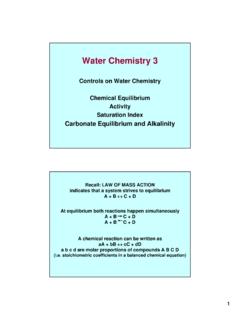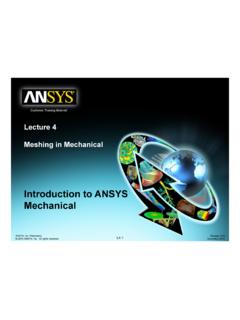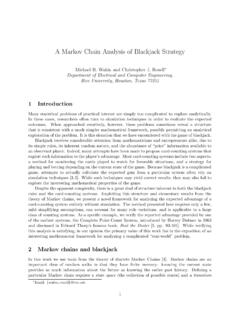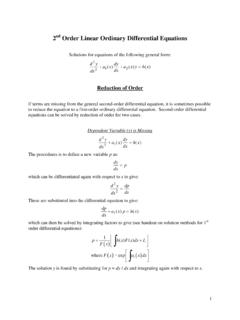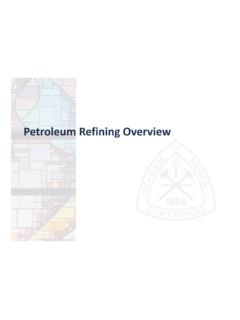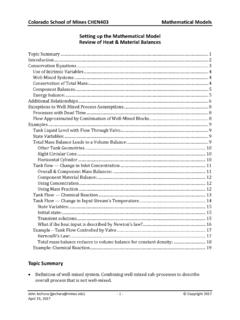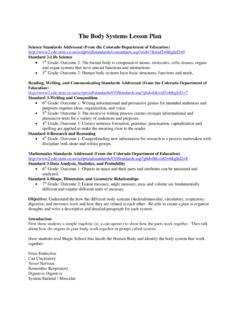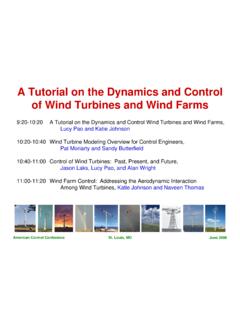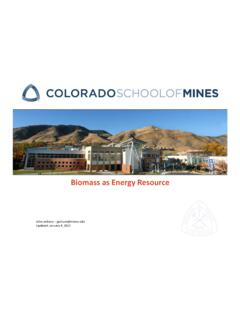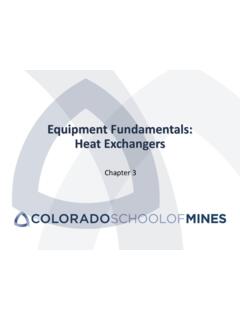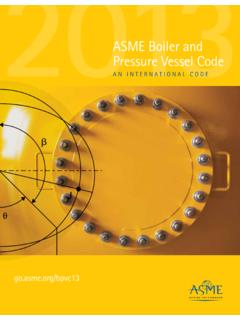Transcription of Natural Steam Methane Reforming (SMR) - Campus Tour
1 John Jechura January 4, 2015 Hydrogen from Natural Gas via Steam Methane Reforming (SMR)Energy efficiency of hydrogen from Natural gas Definition of energy efficiency From basic stoichiometry CH4+ 2 H2O CO2+ 4 H2 Fuel to satisfy the heat requirements From real processes SMR Steam Methane Reforming Water shift reactions Heat integration CO2removal or PSA?2 Energy Efficiency outiniEE Usable energy out of a process compared to all energy inputs Energy values could be heat, work, or chemical potential (heating value) HHV (Gross):Fuel + O2 CO2+ H2O (liquid) LHV (Net):Fuel + O2 CO2+ H2O (vapor) Energy values may have to be discounted when combining different types Should the HHV be discounted when combining with heat values?
2 HHVLHVBtu/scf Btu/scf Btu/scf Data BookHHVLHVD erived from Aspen Plus Stoichiometery CH4+ 2 H2O CO2+ 4 H224 HCHmol4molNN Production: Apparent efficiency (HHV basis) Just from stoichiometry: Include heat of reaction:4 METHANEWATERH2-CO2Q-RXNQMAKE-H24 How do we provide the heat of reaction? molNN Could use additional Methane mol fuel/mol reactant (HHV basis) Production: Efficiency including fuel (HHV basis) METHANEWATERH2-CO2Q-RXNFUELAIRFLUE-GASMA KE-H2 BURNER5 Steam Methane Reforming & Water Gas ShiftSteamNatural GasReforming ReactorHigh Temperature Shift ReactorLow Temperature Shift ReactorHydrogen PurificationFuel GasFlue GasHydrogenMethanation ReactorCO2 Reforming .
3 Endothermic catalytic reaction, typically 20 30 atm & 800 880 C (1470 1615 F) + H2O CO + 3 H2 Shift conversion. Exothermic fixed bed catalytic reaction, possibly in two steps. CO + H2O CO2+ H2 HTS: 345 370 C (650 700 F)LTS: 230 C (450 F) Gas Purification. Absorb CO2(amine) or separate into pure H2stream (PSA or membrane). Methanation. Convert residual CO & CO2 back to Methane . Exothermic fixed bed catalytic reactions at 370 425 C (700 800 F).CO + 3 H2 CH4+ H2 OCO2+ 4 H2 CH4+ 2 H2O6 SMR Alternate Designs Traditional with 2 stages shift reactors 95% to 98% purity Newer designs with PSA (Pressure Swing Adsorption) lower capital costs, lower conversion, but very high purity (99%+) 7 Process ConsiderationsKaes [2000]Molburg & Doctor [2003]Nexant Report [2006]OtherModel as conversion reactorModel as equilibrium compounds converted to H2S & adsorbed in ZnO temperature increase500 - 800 F depending on technology.
4 700 F most up to 725 psi (50 bar)Reformer1450 - 1650 F exit1500 F20 - 30 atm (295 - 440 psia)Equilibirium Gibbs reactor with 20 F approach (for design).Model as equilibrium F (455-540 C) inlet1470-1615 F (800-880 C) outlet650 - 700 F entrance for HTS + LTS660 F entrance940 F (504 C) inlet500 - 535 F entrance when no LTSE quilibirium Gibbs reactorFixed 90% CO conversionAll components inert except CO, H2O, CO2, & - 450 F entrance400 F entranceEquilibirium Gibbs reactor480-525 F (249-274 C) outletAll components inert except CO, H2O, CO2, & 90% CO conversionMethanation500 - 550 F entranceEquilibirium Gibbs reactorAll components inert except CH4, CO, H2O, CO2, & Purification Model as component splitterModel as component splitterMDEA circulation, duty, & work estimates from GPSA Data BookTreated gas 10 - 15 F increase, 5 - 10 psi decrease, water saturatedTreated gas 100 F & 230 psi (16 bar)
5 ExitRejected CO2 atmospheric pressure & water saturated95% CO2 recoveryPSAM odel as component splitterModel as component splitter100 F entrance90% H2 recovered75 - 85% recovery for "reasonable" capital costs (higher requires more beds)H2 purity as high as contains product stream as contaminant200 - 400 psig feed pressure for refinery applications4:1 minimum feed:purge gas ratio. Purge gas typically 2 - 5 ReactorsHigh Temperature Shift ReactorLow Temperature Shift Reactor8 HIERARCHYAMINEHIERARCHYHVAL-1 HIERARCHYHVAL-2381CO23315151 FEEDPRODUCT381427328Q81519151 WATER1628WQ231283772834918Q4271820417213 16Q3815QW26014Q-HEAT1Q33514 HOTPRODQREFORMERWATPUMPSTEAMGENHTSLTSCON D1 GASCOMPMETHANTRB asic SMR ProcessTemperature (C)Pressure (atm)
6 Remember, direction of arrow indicates whether AspenPlus has calculated, NOT whether it is heat in/out 9 SMR Basic Process Energy RequirementsHIERARCHYHVAL-1 HIERARCHYHVAL-2 FEEDPRODUCTQWATERWQQQQCO2 WREFORMERWATPUMPSTEAMGENHTSLTSCOND1 GASCOMPHIERARCHYAMINEMETHANTRTREATEDTREA TED2 HOTPRODQQE nergy InputsEnergy Removalkcal/hrkWkcal/hrSteam Boiler3,742,371 Post Reformer Cooler2,238,933 Reformer6,332,965 Post HTS Cooler1,026,525 Amine Duty5,680,514 Post LTS Cooler2,305,814 Methanator Reheat553,190 Amine Coolers3,550,321 Sub-total16,309,040 Product Cooler800,533 Total9,922,126 BFW Pump10, Compressor385, Power125, ,246 Total16,831,286 Heating Values (HHV)kcal/hrkmol/hrkcal/molNatural Gas In21,363, Out25,938, H2 Purity.
7 89%H2 Product25,938,163 Total Inputs38,194,356 Efficiency68%10 HIERARCHYHVAL-1 HIERARCHYHVAL-2 FEEDPRODUCTQWATERWQQQQCO2 WREFORMERWATPUMPSTEAMGENHTSLTSCOND1 GASCOMPHIERARCHYAMINEMETHANTRTREATEDTREA TED2 HOTPRODQQSMR Heat Recovery for Steam GenerationEnergy InputsEnergy Removalkcal/hrkWkcal/hrSteam Boiler3,742,371 Post Reformer Cooler2,238,933 Methanator Reheat553,190 Post HTS Cooler1,026,525 Heat Sub-total4,295,561 Post LTS Cooler2,305,814 Sub-total5,571,272 Reformer6,332,965 Amine Duty5,680,514 Amine Coolers3,550,321 Sub-total16,309,040 Product Cooler800,533 Total9,922,126 BFW Pump10, Compressor385, Power125, ,246 Total16,831,286 Heating Values (HHV)kcal/hrkmol/hrkcal/molNatural Gas In21,363, Out25,938, H2 Purity.
8 89%H2 Product25,938,163 Net Inputs33,898,795 Efficiency77%11 Reformer Furnace Design Hydrogen Production by Steam Reforming Ray Elshout, Chemical Engineering, May 201012 HIERARCHYD irect Fired Heaters for Reformer & Amine UnitEnergy InputsEnergy Removalkcal/hrkWkcal/hrSteam Boiler3,742,371 Post Reformer Cooler2,238,933 Methanator Reheat553,190 Post HTS Cooler1,026,525 Heat Sub-total4,295,561 Post LTS Cooler2,305,814 Reformer Flue Gas 648,651 Reformer6,332,965 Sub-total6,219,923 Amine Duty5,680,514 Sub-total16,309,040 Amine Coolers3,550,321 Product Cooler800,533 BFW Pump10, ,570,777 Gas Compressor385, Power125, ,246 Total16,831,286 Heating Values (HHV)kcal/hrkmol/hrkcal/mol EfficiencyNatural Gas In21,363, Fuel Gas8,184, Unit Fuel Gas6,659, ,206, Out25,938, H2 Purity:89%H2 Product25,938,163 Net Inputs36,728,805 Efficiency71%13 HIERARCHYPre Heat the Reformer Feed?
9 Energy InputsEnergy Removalkcal/hrkWkcal/hrSteam Boiler3,742,371 Post Reformer Cooler2,238,933 Methanator Reheat553,190 For Feed Preheat-1,200,000 Heat Sub-total4,295,561 Post HTS Cooler1,026,525 Post LTS Cooler2,305,814 Reformer5,132,965 Reformer Flue Gas 1,673,228 Feed Preheat1,200,000 Sub-total6,044,500 Amine Duty5,680,514 Sub-total16,309,040 Amine Coolers3,550,321 Product Cooler800,533 BFW Pump10, ,395,354 Gas Compressor385, Power125, ,246 Total16,831,286 Heating Values (HHV)kcal/hrkmol/hrkcal/mol EfficiencyNatural Gas In21,363, Fuel Gas7,978, Unit Fuel Gas6,659, ,000, Out25,938, H2 Purity.
10 89%H2 Product25,938,163 Net Inputs36,523,078 Efficiency71%14 SMR Alternate Designs Traditional with 2 stages shift reactors 95% to 98% purity Newer designs with PSA (Pressure Swing Adsorption) lower capital costs, lower conversion, but very high purity (99%+) 15 Alternate Hydrogen Purification Processes Hydrogen Production by Steam Reforming Ray Elshout, Chemical Engineering, May 201016 WQQQQWQQSEPUse of PSA for Product PurificationEnergy InputsEnergy Removalkcal/hrkWkcal/hrSteam Boiler3,742,371 Post Reformer Cooler2,238,933 Feed Preheat1,200,000 For Feed Pre-Heat-1,200,000 Reformer5,132,965 Post HTS Cooler1,026,525 Sub-total10,075,336 Post LTS Cooler1,776,046 Reformer Flue Gas 1,674,739 BFW Pump10, ,516,243 Gas Compressor385, ,529 Total10,471,865 Heating Values (HHV)
